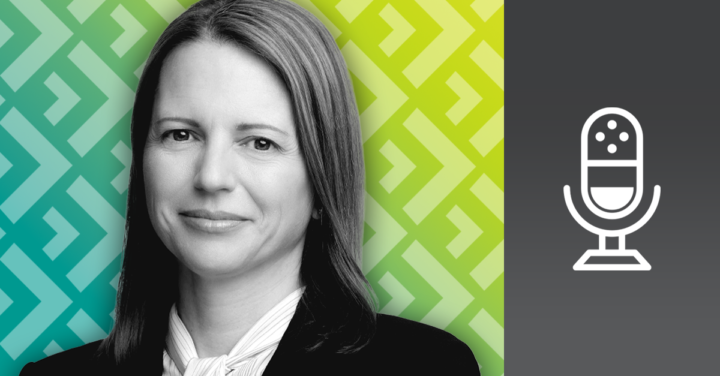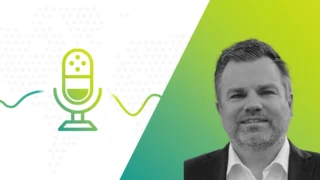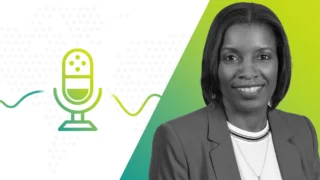
The creation of the new University Pension Plan of Ontario was a significant challenge, but the leadership of CEO and CIA member Barbara Zvan led to a successful launch – and resulted in her being named overall CEO of the Year by Report on Business Magazine. Barbara joins us on this special episode to discuss her experiences as both an actuary and a business leader.
NO TIME TO LISTEN? READ THE TRANSCRIPT.
Fievoli: Welcome to Seeing Beyond Risk, a podcast series from the Canadian Institute of Actuaries. I’m Chris Fievoli, Staff Actuary, Communications and Public Affairs, at the CIA.
From time to time, we like to feature actuaries who have gone on to fill interesting and important roles. Today, we’ll be speaking with Barb Zvan, a CIA member who also serves as president and CEO of the University Pension Plan of Ontario.
Thanks very much for joining us on the podcast today.
Zvan: Thanks for having me here, Chris, and it’s great to be here.
Fievoli: That’s great. Well, let’s start off by giving us a brief overview of your actuarial career. How did you get into actuarial science? And you also spent some time with the Ontario Teachers’ Pension Plan, so talk to us about your experience from getting into the career to where you were recently.
Zvan: So if I go back, as a young person I really enjoyed math and the sciences, but in particular, I really enjoyed the math.
I didn’t actually know where that was going to lead me, but I figured a combo of hard work and education will kind of figure itself out. And I didn’t go to a traditional university with an act sci program at the time. I was at McMaster and a professor just kind of said, “Hey, you should think about writing these exams.” And I did.
And I appeared on some list, and I ended up being a student at Mercer, which was a great experience. You know, the first real business experience. And then during my master’s program, I started getting interested in investments and finance. And at that time, the actuarial exams started to bring in the investment track.
And post master’s, I ended up at one of the banks and I started pricing currency options. So this was the early days of financial mathematics, and it just didn’t feel like the right fit for me. It was a very narrow topic, and you were trying to solve very particular problems.
And then I started seeing Ontario Teachers’ in the newspaper. And if you recall, the first CEO was Claude Lamoureux, and he was talking about what he was doing, and it kind of checked all the boxes. It enabled me to leverage my actuarial interests and my investment interests, and Claude spoke truly as a visionary about what he was trying to do at Teachers’.
So I kind of jumped at the chance of going there for my first junior role, and it was around 1995, which will date myself, and I started as an assistant portfolio manager in a team called Research and Economics. And I have to say, it was absolutely great journey. I was always working on really interesting challenges, and I would say a common thread in the type of work I did, without getting into the long list, was big-picture issues.
The first effort was to internalize their asset-liability model, which, with my background, was a dream first assignment, which led me initially contributing to the development of the annual investment plans to, years later, leading the development of those investment plans.
And everyone thinks of Ontario Teachers’ as it is today. But I have to tell you, in the 1990s, when it first started, it was seeded with 100% bonds, and these bonds were deemed nonmarketable, so you couldn’t sell them. So that was a huge constraint, which brought a lot of creativity – I think this is the benefit.
And eventually we got the portfolio into new asset classes, and they were globally diverse, including real assets. We had liability-driven programs, and we started incorporating leverage, which was unique for many pension plans. I got to work on things like a risk-budgeting framework that spurred active management strategies. I got to work with the partners, the Ontario Teachers’ Federation and the Ontario government, who are a key part of the governance.
And they made the big-picture decisions on the contribution rates and the benefits, which really impacts the long-term sustainability of the plan. And then you think, “I was there through the global financial crisis,” and I was asked to serve as the chief investment risk officer afterwards.
And if you think of the financial institutions after 2008, we had significant projects in place to enhance the risk measurement capability, the advancement of the risk culture. I was asked to join the executive leadership team at that time. And then with all the big-picture issues and the risk lens, we started understanding the environmental, social and governance, or ESG, issues and started getting involved in sustainability and climate change.
And through all that, the great part was also that there was a great community of pension plans, locally and globally, that you got to network with and share and learn from. So just a fabulous journey through that organization.
Fievoli: Great, and now you’re currently the president and CEO of the University Pension Plan of Ontario. You’ve been in that role for a couple of years.
Can you share with us some of the challenges you faced in that role, both personally and also in your day-to-day activities, and some of the things that have been happening with the University Pension Plan?
Zvan: Sure. So just a brief history of the University Pension Plan, or UPP for short. It’s relatively new, as you know. It’s a jointly sponsored defined benefit pension plan.
So the employer and employees share the governance and share the risk. It’s relatively new – it started July 1, 2021 – but the process of creating it with those employer and employee groups started about 10 years ago, actually. And when you looked at the university sector – it was probably post 2008 – and when you were looking at their pension plans, they were in different financial states, they had different designs and some universities did and still do have more than one.
And so what’s amazing is discussions began through university administrators, the faculties and unions saying, “If we had a white sheet of paper, what might we look for in a pension plan?”. And that’s what they created UPP to be, and they really tried to emulate the best of the Canadian model, but I would say the mid-size.
So we have three founding universities that went live on July 1, 2021, which are Queen’s, the University of Toronto and the University of Guelph. And today we have 16 participating organizations from four universities. They’re all related to the university sector. We have about 37,000 members and about $12 billion in assets.
When you look, that was a lot of perseverance and courage to do that. And so we try to honour that spirit, and our goal at the end of the day is we want to build this pension plan for scale, we want members to be proud, and we want to give other universities a reason to join to give more and more retirement security and stability to more groups of people.
But your question was about challenges. I started one year before launch, in July 2020, so right at the start of COVID. It was me, myself and I. There was no office, there was no phone, there was not a stapler. We hadn’t even gotten all the regulatory approvals yet. So it was really a clean sheet of what to do, and I can honestly say it’s really incredibly hard to get a bank account without a lawyer, a CFO, an office phone number. But we managed to get that started.
It was in the middle of the pandemic, so just like the rest of the world, myself, my team that was starting to grow, we had to learn how to do everything virtually. But what was a little bit unique for UPP is that teams that left organizations and went home kind of knew each other.
We actually had a whole new group of people that didn’t even know each other that had to work virtually. To put that in perspective, I did a Globe and Mail article, and my comment was that I didn’t know who was the shortest and who was the tallest. So the group at the time went to a park, placed themselves six feet apart, and took a photo to let me know who was shortest and who was tallest. So just interesting that we had never met in person before.
Another thing was we had an unmissable deadline of July 1, 2021. So as I said, we had one year to get ready, which was quite the feat, making sure that everyone stayed focused on what were the most important things we had to do to be ready. So those are kind of organizational.
And then when it comes to individuals, when you move from being in a role to becoming a CEO, the one thing I would say is you move from having one boss to having a full board. So you end up spending a lot of time with your whole board. And for us, they were also brand new, and they also had to work through the fact that everything was new – absolutely everything. We didn’t have one policy written, one framework, any controls.
In 2021, to give you a sense, we had almost 80 board meetings, and this year there will be about 60. And hopefully next year there will be a lot fewer now that we have a really strong foundation in place. They too had to work barely knowing each other, and they had to work virtually.
And I would say another challenge which became obvious over time is that we had this brand-new team, and they came with a variety of professional backgrounds. Some came from large plans, some came from smaller organizations, and we had to figure out how to do things.
It ended up meaning that we had to be, as leaders, really accessible to get everyone figuring out, “OK, this is the way that we’re going to do it.” So a lot more time maybe than expected at the beginning, but again, totally a fun journey, really bringing the early days of Ontario Teachers’ to UPP, but I would say with the fast-forward button on.
Fievoli: It certainly was an interesting time to launch a new initiative like that. And of course, now we’re feeling the after-effects of the pandemic with inflation and not knowing how the economy is going to react to that. How do you and your team respond to disruptions like that in managing your activities?
Zvan: As a pension fund, you have to take the longer view of risk and opportunity. Fortunately, the fund is quite well diversified to help withstand volatility in the shorter term, which was great in the assets that we inherited from the founding universities.
And the framing that we have placed around our investment strategy is not about predicting for the future, it’s really about trying to build resiliency into the portfolio, and trying to think of whether the things that worked for the last 15 years or something will apply for the next 15.
So that’s a big theme when you’re trying to manage pension plans, and so through this program, we did a deep dive into everything that we inherited, we went through all the external managers, we did an A-L study pretty much starting as soon as I began.
And we got some really good insights about how you move from a single employer pension plan to a jointly sponsored pension plan, we made some changes that hopefully were for the better.
And then, on a longer-term front again, one being the opportunity to increase our private market exposure. So knowing the role of this asset class for so many pension plans, we decided to invest in those capabilities early, and hopefully we’ll have some announcements in the not-too-distant future about that in terms of opportunities, and really trying to scale up our inflation hedging as well. So lots of things that I can’t mention in very specific detail, but really trying to take advantage of the scale that we have, and we have a nice-sized team to focus on these challenges.
And the other thing we could do, because we inherited three portfolios that we immediately took advantage of, is cost savings. We had sometimes three of something that we only needed one of, and we can negotiate better fees, which is also benefitting our members.
Fievoli: Well, let’s take a step back and talk a little bit about your actuarial training. I’d like to get at how you feel that’s been an asset to you throughout your career, and at the same time, can you talk a bit about how actuaries are perceived amongst the people you work with who are outside of the profession?
Zvan: I’ll relate it back to why I chose the actuarial path.
I like the fact that as an actuary, you’re solving real-world problems that affect society. If you think about an individual, by providing a pension plan, we’re providing retirement security. Someone in insurance helps them not to worry if something happens in their life in terms of being able, for example, to take care of themselves or loved ones.
And if you can provide these things well, as a society, it just makes the society better and richer. So the purpose-driven nature of it is really attractive. If you combine that with the actuarial training – I think the one thing it does superbly is naturally making you think long term.
When you think about life insurance, when you think about pensions, it’s all about the long term. When you’re back in school, you’re doing present values for long into the history, and then you start thinking about risk, and risk in terms of the long term. So, I think that mindset, and instilling it early in someone’s career, is really important, and it never leaves you.
Now actuaries, I would say, definitely are a smart group, and definitely a group with integrity and purpose, going back to where I started. I would say a very committed group that’s not scared of hard work or rolling up the sleeves.
It’s evident by the fact that to get into this profession, you have to pass quite a few exams. I think my first boss called me masochistic for doing all those, and I think people often would have images of actuaries in a meeting. And I’ve seen this myself where everyone is whipping out their calculators, that type of thing, but generally as a group, they’re seen as a smart group, as a group that has a lot of integrity and purpose.
Fievoli: That’s good. A few minutes ago, you mentioned that you had something like 80 board meetings in the first year of setting up the pension plan, but I do know that you’ve worked on other boards of directors.
I’m just curious what skills you think you were able to develop by having that experience, and for the other actuaries who would like to get into that, what suggestions do you have for them?
Zvan: With a board member, it’s really a shift. Because a board member’s primary role is oversight, not doing, right? So it’s a clear shift from a management role, and sometimes it does take a bit of practice and training.
And when you think about a board, it’s a group of people generally from diverse backgrounds and skills. And I think one thing that’s really important around being on a board is the ability to bring together those different skills to really listen to what your other board members are saying and adding. Helping build the C, which often means it’s not 100% “everybody agrees,” but where can you get to a consensus and get to a decision to help and support management, because you really do want to enable management to move forward.
As a board member, you have to contribute, you have to be in there actively and be very positive. And as a chair in particular, which I’ve had the privilege of being, is about navigating that boardroom, kind of being the conductor to help orchestrate that consensus. So I think that ability to listen and figure out how do we get to a consensus to support management is a really important part of what a board does. And one thing I often say is that as a board member, your most powerful tool is the questions that you ask.
When you’re in a management role, you can ask lots of questions. But as a board member, it’s really key to think, “OK, what are those key questions at the board meeting that I’m going to ask that will make a difference?” And if you’re preparing for a board meeting, that’s a good way to think about the material. Honestly, governance isn’t a topic you typically get trained on as an actuary. But fortunately, there’s a lot of great material out there – best practices and things like that.
So good resources, like the Canadian Coalition for Good Governance. That’s a mouthful, so look for CCGG. It has guidance on high-performing boards and The Directors’ E&S Guidebook.
And you also can take courses. There’s The Directors College or ICD, and they’re really helpful because they provide you with the theory and the foundation behind a board and how it works. They’re usually based off peer learning off of cases, so it’s a great peer learning environment.
And I would say the best way to start is to pick a volunteer board. The first one I started on was the Pension Investment Association of Canada. So, a friendly board, lots of great peers, a topic that you know well, and it really helps you start building those board skills. And then after getting a little bit of experience, you can start taking some of the courses and just work your way up into more complex organizations.
Fievoli: Before we wrap up, I wanted to mention that recently The Globe and Mail announced that you were selected as one of the top five CEOs of 2022. Can you give us a little bit more information about that honour?
Zvan: Yes! I was really surprised, because I found out through an email. I’m really honoured.
It was really an acknowledgement of all the hard work and dedication of everyone at UPP to build our organization with a clear and committed purpose.
We were building from the ground up, as you know, through COVID, through some rough times, and I was pleased that we were able to bring a team together and align them on a system-level sustainable investing approach, which is also an area I’ve dedicated a lot of my time to, which I think they also picked up on. It really demonstrated the power of collaboration.
The Globe notes that the one award I have out of the five is the Corporate Citizen Award. It’s about the idea that businesses can do well by doing good, and I truly believe that. And everything we do at UPP is about funding a secure pension for members into the future.
On the sustainability side, that means there needs to be a planet and economy for the members to retire into, and we just see all these topics as interrelated, and I think that’s where the citizen aspect comes in.
We’re hoping to create unique value for members and hopefully work with like-minded peers to amplify that impact. So, kind of a long answer, the award is about the idea that businesses can do well by doing good, and I think pension plans are well suited for that.
Fievoli: That’s great. Congratulations on that and thank you very much for coming to speak to us on the podcast today.
And just a quick postscript: subsequent to the recording of this episode, it was announced that Barbara was named Overall CEO of the Year, so congratulations on that honour.
If you enjoyed today’s conversation, please subscribe to our podcast and catch up on prior episodes. As well, if you have any ideas for future episodes or would like to contribute to our Seeing Beyond Risk blog, we’d love to hear from you. Contact information can be found in the show description.
Until next time, I’m Chris Fievoli and thank you for tuning in to Seeing Beyond Risk.
This transcript has been edited for clarity.





